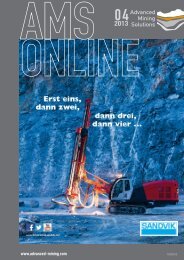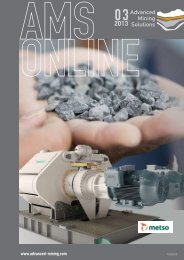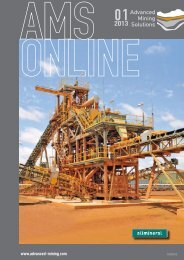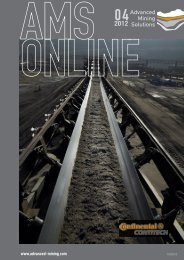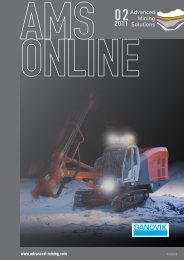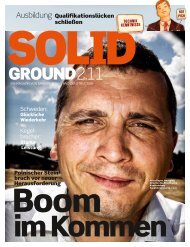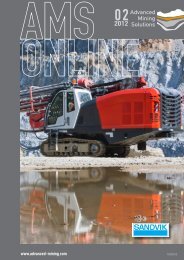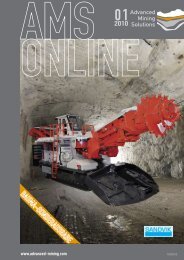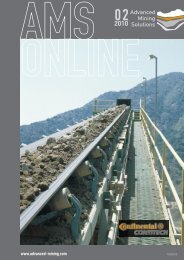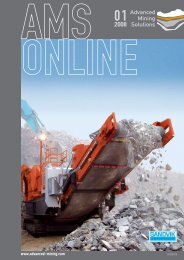A new face drilling rig for narrow tunnels and ... - Advanced Mining
A new face drilling rig for narrow tunnels and ... - Advanced Mining
A new face drilling rig for narrow tunnels and ... - Advanced Mining
You also want an ePaper? Increase the reach of your titles
YUMPU automatically turns print PDFs into web optimized ePapers that Google loves.
calculation methods , the calculation of the drive power is<br />
not accessible with an analytical observation. Effects such<br />
as entrapment or destruction of good in the gap between<br />
screw pitch <strong>and</strong> tube, which significantly increase the<br />
energy dem<strong>and</strong>s <strong>for</strong> conveyance, are too manifold to be<br />
captured with analytical observations. There<strong>for</strong>e, like in<br />
other operation areas of screw conveyors (horizontal to<br />
slightly inclined <strong>and</strong> vertical), the determination of the<br />
calculation guidelines calls <strong>for</strong> semi-empirical methods to<br />
picture processes that are difficult to capture within the<br />
layout method.<br />
The basis <strong>for</strong> a semi-empirical method is an analytical<br />
base approach, which is exp<strong>and</strong>ed by one or several<br />
empirically determined parameters. The empirical<br />
parameters reflect the influences that cannot be captured<br />
analytically, subjected to the known parameters. As<br />
principle <strong>for</strong>mulas <strong>for</strong> the two parameters, reviewed within<br />
the framework of this project, volume flow <strong>and</strong> drive power,<br />
the <strong>for</strong>mulas known from DIN 15262 [5] are used, <strong>and</strong> are<br />
correspondingly adapted based on theoretical test done in<br />
previous projects.<br />
In order to reliably determine the empirical parameters<br />
<strong>for</strong> the entire application area, a sufficient amount of data<br />
sets <strong>for</strong> the parameters is needed. The needed datasets<br />
are generated with three different methods: Experimental<br />
tests in a large-scale plant, simulations according to the<br />
discrete elements method <strong>and</strong> calculation with numerical<br />
methods, which were developed in preceding projects.<br />
Through this division of data gathering to different methods<br />
it is possible to document all areas of the application area<br />
with data sets.<br />
The obtained data sets are examined in detail with<br />
statistical methods. In an initial step the influences of the<br />
individual parameters are interpreted descriptively with<br />
regard to the type of their influence. Building on this, the<br />
second step incorporates these insights into the models<br />
<strong>for</strong> empirical parameters, which are determined through<br />
regression calculations. The results are simple <strong>for</strong>mulas,<br />
which describe the correlations of the influencing factors<br />
on the parameters <strong>and</strong> allow <strong>for</strong> a reliable <strong>for</strong>ecast.<br />
Together with the analytical base approach it is possible<br />
to calculate the possible volume flow <strong>and</strong> the needed drive<br />
power.<br />
Issue 04 | 2010<br />
TRANSFER OF TECHNOLOGY<br />
Bibliography<br />
[1] Vollmann, A.: Untersuchung der Schüttgutförderung<br />
in geneigten Schneckenförderern; Dissertation, München,<br />
Technische Universität München, 2000<br />
[2] Günthner, W. A.; Fottner, J.; Rong, O.: Empirische<br />
Entwicklung von Kenngrößen zur Auslegung von Hochleistungs-<br />
Schneckenförderern für Schüttgut; Herbert Utz Verlag, München,<br />
2002<br />
[3] Günthner, W. A.; Blomeyer, N.; Rong, O.: Entwicklung<br />
von praxistauglichen Auslegungsverfahren für Schüttgut-<br />
Hochleistungs-Schneckenförderer, Forschungsbericht, Lehrstuhl<br />
für Fördertechnik Materialfluss Logistik, Technische Universität<br />
München, Garching bei München, 2006<br />
[4] Blomeyer, N.: Erweiterung und Verifikation von<br />
Auslegungsverfahren für Hochleistungs-Schneckenförderer<br />
für Schüttgut; Dissertation, München, Technische Universität<br />
München, 2008<br />
[5] DIN 15262:1983-01: Stetigförderer - Schneckenförderer<br />
für Schüttgut - Berechnungsgrundsätze, Deutsches Institut für<br />
Normung e.V.<br />
[6] Rong, O.: Auslegungsverfahren für Hochleistungs-<br />
Schneckenförderer; Dissertation, München, Technische<br />
Universität München, 2004<br />
[7] Gabler, H.: Theoretische und experimentelle<br />
Untersuchung der Förderung in steilen und senkrechten<br />
Schneckenförderern; Dissertation, München, Technische<br />
Universität München, 1981<br />
[8] Greinwald, K.: Untersuchung der Förderung leicht<br />
fließender Schüttgüter im senkrechten Schneckenförderer unter<br />
Berücksichtigung der Zwischenlager; Dissertation, München,<br />
Technische Universität München, 1994<br />
[9] Fottner, J.: Auslegung und wirtschaftlicher Einsatz von<br />
Hochleistungs-Schneckenförderern; Dissertation, München,<br />
Technische Universität München, 2002<br />
[10] Katterfeld, A.; Krause, F.: Funktionsanalyse eines<br />
Rohrkettenförderers mit Hilfe der Diskrete Elemente Methode<br />
(DEM); In: Tagungsb<strong>and</strong> Fachtagung Schüttgutfördertechnik<br />
2004, Technische Universität München, Garching bei München,<br />
2004<br />
[11] FEM 2181:1989: Spezifische Schüttguteigenschaften<br />
bei der mechanischen Förderung, Fédération Européenne de la<br />
Manutention<br />
www.advanced-mining.com<br />
56



